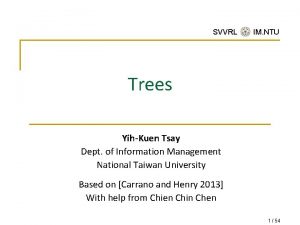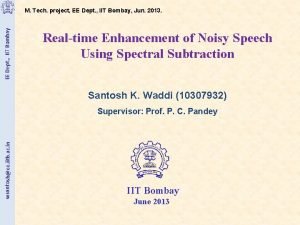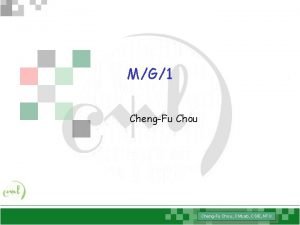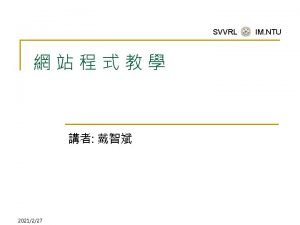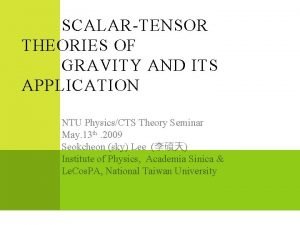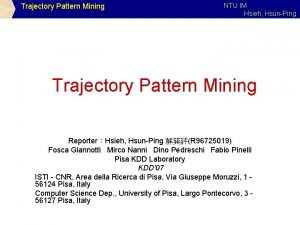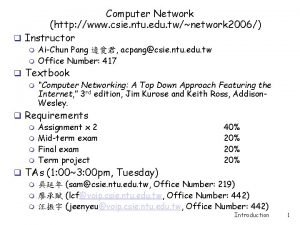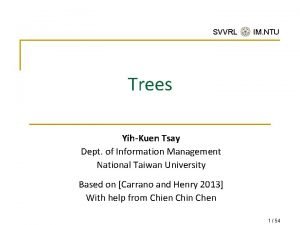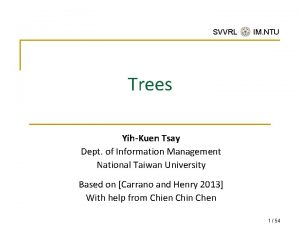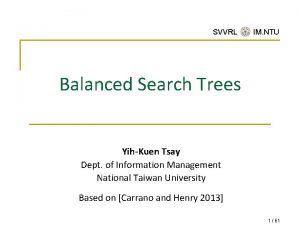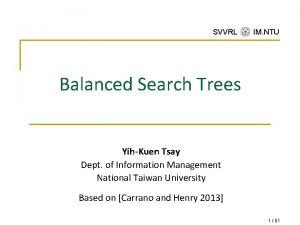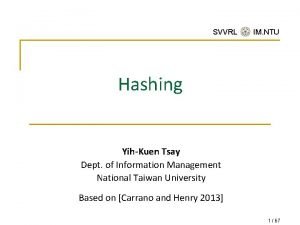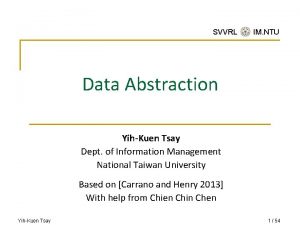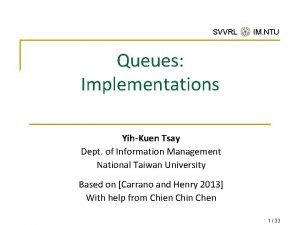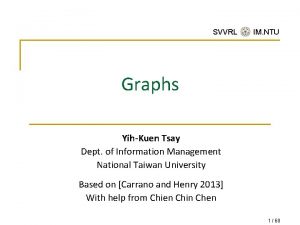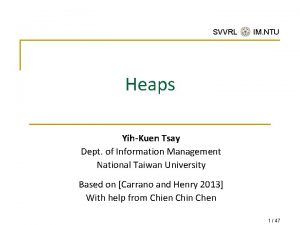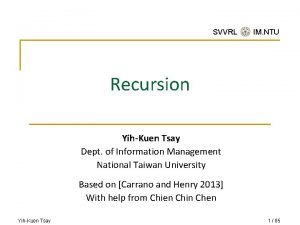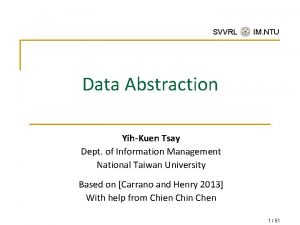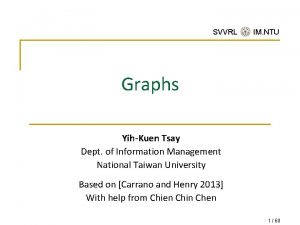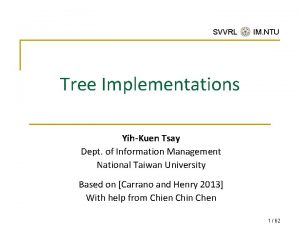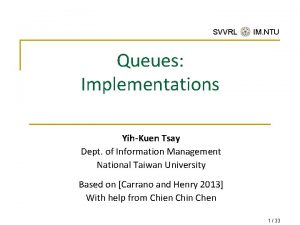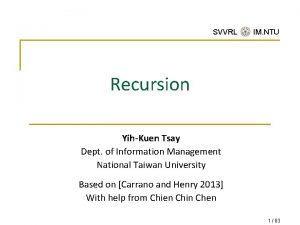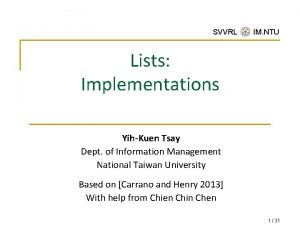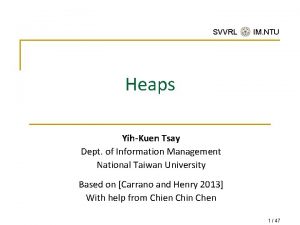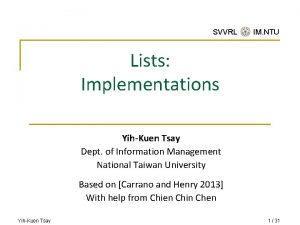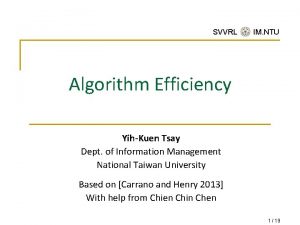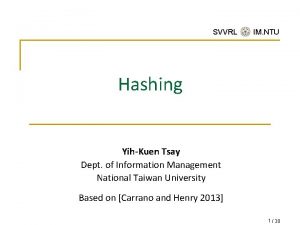SVVRL IM NTU Trees YihKuen Tsay Dept of






















































- Slides: 54

SVVRL @ IM. NTU Trees Yih-Kuen Tsay Dept. of Information Management National Taiwan University Based on [Carrano and Henry 2013] With help from Chien Chin Chen 1 / 54

SVVRL @ IM. NTU Data-Management Operations n Operations on stacks, lists, sorted lists, queues, and priority queues fit into at least one of these categories: q q q n Position-oriented ADTs (stack, queue, and list) q q q n Insert data into a data collection. Delete data from a data collection. Ask questions about the data in a data collection. Insert data into the ith position. Delete data from the ith position. Ask a question about the data in the ith position. Value-oriented ADTs (sorted list and priority queue) q q q Insert data according to its value. Delete data knowing only its value. Ask a question about data knowing only its value. Yih-Kuen Tsay DS 2017: Trees 2 / 54

SVVRL @ IM. NTU Data Organization n Stacks, lists, and queues are linear in their organization of data. q n We will study trees, which organize data in a nonlinear, hierarchical form. q n Data are stored one after another. An item can have more than one immediate successor. Will focus on two ADTs. q q Position-oriented ADT: binary tree Value-oriented ADT: binary search tree Yih-Kuen Tsay DS 2017: Trees 3 / 54

SVVRL @ IM. NTU Terminology (1/3) n n Trees, as a special kind of graphs, are composed of nodes (vertices) and edges. Trees are hierarchical. q n Each node in a tree, except the root, has one parent. q n Parent-child relationship between two nodes, e. g. , B and C are children of A. The root, A, has no parent. A node that has no children is called a leaf of the tree, e. g. , C, D, E, F. Source: FIGURE 15 -1 in [Carrano and Henry 2013]. Yih-Kuen Tsay DS 2017: Trees 4 / 54

SVVRL @ IM. NTU Terminology (2/3) n n Sibling relationship: children of the same parent, e. g. , B and C. Ancestor-descendant relationships among nodes. q q q n A is an ancestor of D. D is a descendant of A. The root of any tree is an ancestor of every node in that tree. Subtree of a tree: any node and its descendants. A subtree example. Source: FIGURE 15 -1 in [Carrano and Henry 2013]. Yih-Kuen Tsay DS 2017: Trees 5 / 54

SVVRL @ IM. NTU Terminology (3/3) n The hierarchical property of a tree: q Can be used to represent information that itself is hierarchical in nature, e. g. , organization chart or family tree. Source: FIGURE 15 -2 in [Carrano and Henry 2013]. Yih-Kuen Tsay DS 2017: Trees 6 / 54

SVVRL @ IM. NTU Kinds of Trees n A general tree T is a set of one or more nodes such that T is partitioned into disjoint subsets: q q n A single node r, the root. Sets that are empty or general trees, called subtrees of r. An n-ary tree T is a set of nodes that is either empty or partitioned into disjoint subsets: q q A single node r, the root. n possibly empty sets that are n-ary subtrees of r. An example of 3 -ary tree Yih-Kuen Tsay DS 2017: Trees 7 / 54

SVVRL @ IM. NTU Binary Trees (1/2) n A binary tree is a set T of nodes such that either: q q T is empty, or T is partitioned into disjoint subsets: n n A single node r, the root. Two possibly empty sets that are binary trees, called the left subtree of r and the right subtree of r. Each node in a binary tree has no more than two children. Source: FIGURE 15 -2 in [Carrano and Henry 2013]. Yih-Kuen Tsay DS 2017: Trees 8 / 54

SVVRL @ IM. NTU Binary Trees (2/2) n You can use binary trees to represent algebraic expressions. q q Leaves are operands. Evaluation order: bottom-up. n n The hierarchy specifies an unambiguous order for evaluating an expression. Parentheses do not appear in these trees. Source: FIGURE 15 -3 in [Carrano and Henry 2013]. Yih-Kuen Tsay DS 2017: Trees 9 / 54

Binary Search Trees n n SVVRL @ IM. NTU A binary search tree is a binary tree, But has the following properties for each node n: q q q n’s value is > all values in n’s left subtree TL. n’s value is < all values in n’s right subtree TR. Both TL and TR are binary search trees. Source: FIGURE 15 -4 in [Carrano and Henry 2013]. Yih-Kuen Tsay DS 2017: Trees 10 / 54

The Height of a Tree (1/3) n SVVRL @ IM. NTU Height of a tree: q Number of nodes along the longest path from the root to a leaf. Height 3 Height 5 Height 7 Source: FIGURE 15 -5 in [Carrano and Henry 2013]. Yih-Kuen Tsay Trees with the same nodes but different heights. DS 2017: Trees 11 / 54

The Height of a Tree (2/3) n SVVRL @ IM. NTU Level of a node n in a tree T: q q If n is the root of T, it is at level 1. If n is not the root of T, its level is 1 greater than the level of its parent. Level 1 Level 2 Level 3 Source: FIGURE 15 -5 in [Carrano and Henry 2013]. Yih-Kuen Tsay DS 2017: Trees 12 / 54

The Height of a Tree (3/3) n Height of a tree T defined in terms of the levels of its nodes. q q n SVVRL @ IM. NTU If T is empty, its height is 0. If T is not empty, its height is equal to the maximum level of its nodes. A recursive definition of height q q If T is empty, its height is 0. If T is not empty, height(T) = 1 + max{height(TL), height(TR)}. r TL Yih-Kuen Tsay TR DS 2017: Trees 13 / 54

SVVRL @ IM. NTU Full Binary Trees n A binary tree of height h is full if nodes n Recursive definition: at levels < h have two children each. q q If T is empty, T is a full binary tree of height 0. If T is not empty and has height h > 0, T is a full binary tree if the root’s subtrees are both full binary trees of height h – 1. Source: FIGURE 15 -6 in [Carrano and Henry 2013]. Yih-Kuen Tsay DS 2017: Trees 14 / 54

Complete Binary Trees (1/2) n SVVRL @ IM. NTU A binary tree of height h is complete if q q It is full to level h – 1 and Level h is filled from left to right. Source: FIGURE 15 -7 in [Carrano and Henry 2013]. Yih-Kuen Tsay DS 2017: Trees 15 / 54

Complete Binary Trees (2/2) SVVRL @ IM. NTU Another definition: n A binary tree of height h is complete if q q q All nodes at levels <= h – 2 have two children each, When a node at level h – 1 has children, all nodes to its left at the same level have two children each, and When a node at level h – 1 has one child, it is a left child. Level 1 Level 2 Level 3 Level 4 Level 5 Yih-Kuen Tsay DS 2017: Trees 16 / 54

SVVRL @ IM. NTU Balanced Binary Trees n A binary tree is balanced if the heights of any node’s two subtrees differ by no more than 1. (Could be more general. ) q q Complete binary trees are balanced. Full binary trees are complete and balanced unbalanced Source: FIGURE 15 -7 and 15 -5 in [Carrano and Henry 2013]. Yih-Kuen Tsay DS 2017: Trees 17 / 54

SVVRL @ IM. NTU The Maximum Height of a Binary Tree n The maximum height of an n-node binary tree is n, by giving each internal node exactly one child. Source: FIGURE 15 -5 in [Carrano and Henry 2013]. Yih-Kuen Tsay DS 2017: Trees 18 / 54

SVVRL @ IM. NTU The Minimum Height of a Binary Tree (1/2) n To minimize the height of a binary tree given n nodes, you must fill each level of the tree as completely as possible. Source: FIGURE 15 -9 in [Carrano and Henry 2013]. Yih-Kuen Tsay DS 2017: Trees 19 / 54

SVVRL @ IM. NTU The Minimum Height of a Binary Tree (2/2) n Yih-Kuen Tsay DS 2017: Trees 20 / 54

The ADT Binary Tree n SVVRL @ IM. NTU As an abstract data type, the binary tree has operations that: q q Add or remove a node Set or retrieve the data in the root Test whether the tree is empty Traverse the nodes, i. e. , visit every node, in the tree n Yih-Kuen Tsay Visit doing something with or to the node. DS 2017: Trees 21 / 54

SVVRL @ IM. NTU Traversals of a Binary Tree (1/7) n A traversal visits each node in a tree. q q You do something with or to the node during a visit. For example, display or modify the data in the node. n n Will assume that visiting means displaying data. With the recursive definition of a binary tree, you can construct a recursive traversal algorithm. q If the tree is not empty, the traversal algorithm must perform these tasks: n n q Display the data in the root. Traverse the two subtrees (recursive … smaller problems). The base case: If the tree is empty, the algorithm takes no action. Yih-Kuen Tsay DS 2017: Trees 22 / 54

SVVRL @ IM. NTU Traversals of a Binary Tree (2/7) n The algorithm has three choices of when to visit the root: q Preorder traversal n q Inorder traversal n q Visit root before visiting its subtrees, i. e. , before the recursive calls. Visit root between visiting its subtrees, i. e. , between the recursive calls. Postorder traversal n Yih-Kuen Tsay Visit root after visiting its subtrees, i. e. , after the recursive calls. DS 2017: Trees 23 / 54

SVVRL @ IM. NTU Traversals of a Binary Tree (3/7) n The preorder traversal algorithm: preorder(bin. Tree: Binarytree): void if (bin. Tree is not empty) { Visit the root of bin. Tree preorder(Left subtree of bin. Tree’s root) preorder(Right subtree of bin. Tree’s root) } 60 20 10 Preorder: 60 20 10 40 30 50 70 40 30 Yih-Kuen Tsay 70 50 DS 2017: Trees 24 / 54

SVVRL @ IM. NTU Traversals of a Binary Tree (4/7) n The inorder traversal algorithm: inorder(bin. Tree: Binarytree): void if (bin. Tree is not empty) { inorder(Left subtree of bin. Tree’s root) Visit the root of bin. Tree inorder(Right subtree of bin. Tree’s root) } 60 20 10 Inorder: 10 20 30 40 50 60 70 40 30 Yih-Kuen Tsay 70 50 DS 2017: Trees 25 / 54

SVVRL @ IM. NTU Traversals of a Binary Tree (5/7) n The postorder traversal algorithm: postorder(in bin. Tree: Binarytree): void if (bin. Tree is not empty) { postorder(Left subtree of bin. Tree’s root) postorder(Right subtree of bin. Tree’s root) Visit the root of bin. Tree } 60 20 10 Postorder: 10 30 50 40 20 70 60 40 30 Yih-Kuen Tsay 70 50 DS 2017: Trees 26 / 54

SVVRL @ IM. NTU Traversals of a Binary Tree (6/7) n Each of these traversals visits every node in a binary tree exactly once. q n Each visit performs the same operations on each node, independently of n. q n n visits occur for a tree of n nodes. It must be O(1). Thus, each traversal is O(n). Yih-Kuen Tsay DS 2017: Trees 27 / 54

SVVRL @ IM. NTU Traversals of a Binary Tree (7/7) n The task of a tree traversal can be more than to display each item when you visit it. q q Copy the item or even alter it. Thus, you might devise many different traversal operations: n n preorder. Traverse. And. Display, preorder. Traverse. And. Copy, … A better solution: devise a traversal operation that can call a function to perform a task on each item in the tree. q q Function of displaying, copying, or altering items. The client defines and passes this function as an argument to the traversal operation. For instance: bintree. preorder. Traverse(display); Next chapter will discuss the implementation details. Yih-Kuen Tsay DS 2017: Trees 28 / 54

Binary Tree Operations (1/5) SVVRL @ IM. NTU is. Empty() Task: Tests whether this binary tree is empty. Input: None. Output: True if the binary tree is empty; otherwise false. get. Height() Task: Gets the height of this binary tree. Input: None. Output: The height of the binary tree. get. Number. Of. Nodes() Task: Gets the number of nodes in this binary tree. Input: None. Output: The number of nodes in the binary tree. Yih-Kuen Tsay DS 2017: Trees 29 / 54

Binary Tree Operations (2/5) SVVRL @ IM. NTU get. Root. Data() Task: Gets the data that is in the root of this binary tree. Input: none. Output: The root’s data set. Root. Data(new. Data) Task: Replaces the data item in the root of this binary tree with new. Data, if the tree is note empty. However, if the tree is empty, inserts a new root node whose data item is new. Data into the tree Input: new. Data is the data item. Output: None. add(new. Data) Task: Adds a new node containing a given data item into this binary tree. Input: new. Data is the data item. Output: True if the addition is successful, or false if not. The specification of add is intentionally vague, and gives the programmer flexibility. Yih-Kuen Tsay DS 2017: Trees 30 / 54

Binary Tree Operations (3/5) SVVRL @ IM. NTU remove(data) Task: Removes the node containing the given data item from this binary tree. Input: data is the data item. Output: True if the removal is successful, or false if not. clear() Task: Removes all nodes from this binary tree. Input: None. Output: None. (The tree is empty. ) get. Entry(an. Entry) Task: Gets a specific entry in this binary tree. Input: an. Entry is the desired data item. Output: The entry in the binary tree that matches an. Entry. Throws an exception if the entry is not found. Yih-Kuen Tsay DS 2017: Trees 31 / 54

Binary Tree Operations (4/5) SVVRL @ IM. NTU contains(data) Task: Tests whether the given data item occurs in this binary tree. Input: data is the data item. Output: True if the binary tree contains the given data item, or false if not. preorder. Traverse(visit) inorder. Traverse(visit) postorder. Traverse(visit) Task: Traverses this binary tree in preorder/inorder/postorder and calls the function visit once for each node. Input: visit is a client-defined function that performs an operation on or with the data in each visited node. Output: None. Yih-Kuen Tsay DS 2017: Trees 32 / 54

Binary Tree Operations (5/5) SVVRL @ IM. NTU UML diagram for the class Binary. Tree Source: FIGURE 15 -12 in [Carrano and Henry 2013]. Yih-Kuen Tsay DS 2017: Trees 33 / 54

SVVRL @ IM. NTU A C++ Interface for the ADT Binary Tree (1/4) #ifndef _BINARY_TREE_INTERFACE #define _BINARY_TREE_INTERFACE template<class Item. Type> class Binary. Tree. Interface { public: /** Tests whether this binary tree is empty. @return True if the binary tree is empty, or false if not. */ virtual bool is. Empty() const = 0; /** Gets the height of this binary tree. @return The height of the binary tree. */ virtual int get. Height() const = 0; /** Gets the number of nodes in this binary tree. @return The number of nodes in the binary tree. */ virtual int get. Number. Of. Nodes() const = 0; Yih-Kuen Tsay DS 2017: Trees 34 / 54

SVVRL @ IM. NTU A C++ Interface for the ADT Binary Tree (2/4) /** Gets the data that is in the root of this binary tree. @pre The binary tree is not empty. @post The root’s data has been returned, and the binary tree is unchanged. @return The data in the root of the binary tree. */ virtual Item. Type get. Root. Data() const = 0; /** Replaces the data item in the root of this binary tree with the given data, if the tree is not empty. However, if the tree is empty, inserts a new root node containing the given data into the tree. @pre None. @post The data in the root of the binary tree is as given. @param new. Data The data for the root. */ virtual void set. Root. Data(const Item. Type& new. Data) = 0; /** Adds a new node containing the given data to this binary tree. @param new. Data The data for the new node. @post The binary tree contains a new node. @return True if the addition is successful, or false not. */ virtual bool add(const Item. Type& new. Data) = 0; Yih-Kuen Tsay DS 2017: Trees 35 / 54

SVVRL @ IM. NTU A C++ Interface for the ADT Binary Tree (3/4) /** Removes the node containing the given data item from this binary tree. @param data The data value to remove from the binary tree. @return True if the removal is successful, or false not. */ virtual bool remove(const Item. Type& data) = 0; /** Removes all nodes from this binary tree. */ virtual void clear() = 0; /** Gets a specific entry in this binary tree. @post The desired entry has been returned, and the binary tree is unchanged. If no such entry was found, an exception is thrown. @param an. Entry The entry to locate. @return The entry in the binary tree that matches the given entry. @throw Not. Found. Exception if the given entry is not in the tree. */ virtual Item. Type get. Entry(const Item. Type& an. Entry) const throw(Not. Found. Exception) = 0; Yih-Kuen Tsay DS 2017: Trees 36 / 54

SVVRL @ IM. NTU A C++ Interface for the ADT Binary Tree (4/4) /** Tests whether a given entry occurs in this binary tree. @post The binary search tree is unchanged. @param an. Entry The entry to find. @return True if the entry occurs in the tree, or false if not. */ virtual bool contains(const Item. Type& an. Entry) const = 0; /** Traverses this binary tree in preorder (inorder, postorder) and calls the function visit once for each node. @param visit A client-defined function that performs an operation on or with the data in each visited node. */ virtual void preorder. Traverse(void visit(Item. Type&)) const = 0; virtual void inorder. Traverse(void visit(Item. Type&)) const = 0; virtual void postorder. Traverse(void visit(Item. Type&)) const = 0; }; // end Binary. Tree. Interface #endif Yih-Kuen Tsay DS 2017: Trees 37 / 54

The ADT Binary Search Tree n n The ADT binary search tree is suitable for searching a tree for a particular data item. For each node n in a binary search tree, q q q n SVVRL @ IM. NTU n’s value is greater than all values in its left subtree TL , n’s value is less than all values in its right subtree TR , and both TL and TR are binary search trees. This organization of data enables you to search a binary search tree for a particular data item efficiently. Source: FIGURE 15 -12 in [Carrano and Henry 2013]. Yih-Kuen Tsay DS 2017: Trees 38 / 54

SVVRL @ IM. NTU Binary Search Tree Operations (1/2) n As an ADT, the binary search tree has operations of inserting, removing, and retrieving data. q q Unlike the position-oriented ADTs stack, list, and queue, but like the ADT sorted list, the insertion, removal, and retrieval operations are by value, not by position. The traversal operations that you just saw for a binary tree apply to a binary search tree without change. n Yih-Kuen Tsay Because a binary search tree is a binary tree! DS 2017: Trees 39 / 54

SVVRL @ IM. NTU Binary Search Tree Operations (2/2) add(new. Entry) Task: Inserts new. Entry into this binary search tree such that the properties of a binary search tree are maintained. Input: new. Entry is the data item to be inserted. Assumes the entries in the tree are distinct and differ from new. Entry Output: True if the insertion is successful, or false if not. remove(an. Entry) Task: Removes the given entry from this binary search tree such that the properties of a binary search tree are maintained. Input: an. Entry is the entry to remove. Output: True if the removal is successful, or false if not. The methods is. Empty, get. Height, get. Number. Of. Nodes, get. Root. Data, clear, get. Entry, contains, preorder. Traverse, inorder. Traverse, and postorder. Traverse have the same specifications as for a binary tree. Yih-Kuen Tsay DS 2017: Trees 40 / 54

SVVRL @ IM. NTU ADT Binary Search Tree: Search (1/4) n Because a binary search tree is recursive by nature, it is natural to formulate recursive algorithms for operations on the tree. search(bst. Tree: Binary. Search. Tree, target: Item. Type) if (bst. Tree is empty) The desired item is not found else if (target == data item in the root of bst. Tree) The desired item is found else if (target < data item in the root of bst. Tree) search(Left subtree of bst. Tree, target) else search(Right subtree of bst. Tree, target) Yih-Kuen Tsay DS 2017: Trees 41 / 54

SVVRL @ IM. NTU ADT Binary Search Tree: Search (2/4) Suppose you want to locate Elisa’s record in the binary tree. Elisa< Jane Elisa > Bob Alan Tom Elisa Nancy Wendy Elisa == Elisa Bingo! Source: FIGURE 15 -16 in [Carrano and Henry 2013]. Yih-Kuen Tsay DS 2017: Trees 42 / 54

SVVRL @ IM. NTU ADT Binary Search Tree: Search (3/4) n n n As you will see, this search algorithm is the basis of the other operations on a binary search tree. Note that the shape of the tree in no way affects the validity of the search algorithm. However, the search algorithm works more efficiently on some trees than on others. Yih-Kuen Tsay DS 2017: Trees 43 / 54

SVVRL @ IM. NTU ADT Binary Search Tree: Search (4/4) n n The shape of a binary search tree affects the efficiency of its operations. The more balanced a binary search tree is, the farther it is from a linear structure. q The behavior of the search algorithm will be to a binary search of an array! Yih-Kuen Tsay DS 2017: Trees 44 / 54

SVVRL @ IM. NTU ADT Binary Search Tree: Insertion (1/2) n n Suppose that you want to insert a record for Frank into the binary search tree. Imagine that you instead want to search for the item with Frank. q Frank must be the right child of Elisa!! Jane Bob Alan Tom Elisa Nancy Wendy Frank Yih-Kuen Tsay DS 2017: Trees 45 / 54

SVVRL @ IM. NTU ADT Binary Search Tree: Insertion (2/2) n Search always tells you the insertion point. q q It will always terminate at an empty subtree. Or, search always tells you to insert the item as a new leaf! Yih-Kuen Tsay DS 2017: Trees 46 / 54

ADT Binary Search Tree: Traversal n n SVVRL @ IM. NTU Traversals for a binary search tree are the same as the traversals for a binary tree. The inorder traversal of a binary search tree visits the tree’s nodes in sorted search-key order. Yih-Kuen Tsay DS 2017: Trees 47 / 54

SVVRL @ IM. NTU Efficiency of Binary Search Tree Operations (1/7) n Each operation compares the a specified value v to the entries in the nodes along a path through the tree. q q Start at the root. Terminate at the node that contains v (or an empty subtree). Elisa < Jane Elisa > Bob Alan Tom Elisa == Elisa Bingo! Yih-Kuen Tsay Nancy Wendy 3 comparisons DS 2017: Trees 48 / 54

SVVRL @ IM. NTU Efficiency of Binary Search Tree Operations (2/7) n n Thus, the efficiency of each operation is related (proportional) to the number of nodes along the comparison path. The maximum number of comparisons is the number of nodes along the longest path from root to a leaf— that is, the tree’s height. Yih-Kuen Tsay DS 2017: Trees 49 / 54

SVVRL @ IM. NTU Efficiency of Binary Search Tree Operations (3/7) n n However, several different binary search trees are possible for the same data!! To locate “Wendy”: Alan Jane Elisa Tom Bob Alan Bob Elisa Nancy Jane Wendy Nancy 3 comparisons 7 comparisons!! Tom Wendy Yih-Kuen Tsay DS 2017: Trees 50 / 54

SVVRL @ IM. NTU Efficiency of Binary Search Tree Operations (4/7) n n n The order in which insertion and deletion operations are performed on a binary search tree affects its height. Now, we try to analyze the maximum and minimum heights of a binary search tree with n nodes. The maximum height of a binary tree with n nodes is n. q By giving each internal node exactly one child. Yih-Kuen Tsay DS 2017: Trees 51 / 54

SVVRL @ IM. NTU Efficiency of Binary Search Tree Operations (5/7) n Yih-Kuen Tsay DS 2017: Trees 52 / 54

SVVRL @ IM. NTU Efficiency of Binary Search Tree Operations (6/7) n Yih-Kuen Tsay DS 2017: Trees 53 / 54

SVVRL @ IM. NTU Efficiency of Binary Search Tree Operations (7/7) Yih-Kuen Tsay DS 2017: Trees 54 / 54
 Elaine tsay
Elaine tsay Yih-kuen tsay
Yih-kuen tsay Dept nmr spectroscopy
Dept nmr spectroscopy Florida dept of agriculture and consumer services
Florida dept of agriculture and consumer services Gome dept
Gome dept Dept ind onegov
Dept ind onegov Rowan county dss child protective services
Rowan county dss child protective services Dept. name of organization
Dept. name of organization Lafd interview
Lafd interview Ohio employment first
Ohio employment first Continuing education library oxford
Continuing education library oxford Nys dept of homeland security
Nys dept of homeland security Florida department of agriculture and consumer services
Florida department of agriculture and consumer services Florida dept of agriculture and consumer services
Florida dept of agriculture and consumer services Gome dept
Gome dept Gome dept
Gome dept Albany county dept of social services
Albany county dept of social services Dept of education
Dept of education Mn dept of education
Mn dept of education Oviposition
Oviposition Affiliation poster presentation
Affiliation poster presentation Nebraska dept of agriculture
Nebraska dept of agriculture Dept a
Dept a Finance departments
Finance departments Gome dept
Gome dept La dept of revenue
La dept of revenue Tabella chemical shift c13
Tabella chemical shift c13 Ms department of finance and administration
Ms department of finance and administration Dept of education
Dept of education Vaginal dept
Vaginal dept Iit
Iit Central islip fire dept
Central islip fire dept Department of inspectional services
Department of inspectional services Hoe dept
Hoe dept Dept. name of organization (of affiliation)
Dept. name of organization (of affiliation) La geaux biz
La geaux biz Pt dept logistik
Pt dept logistik Cati lab ntu
Cati lab ntu Belgrave ntu
Belgrave ntu Ntu.edu.ua:9095
Ntu.edu.ua:9095 Google map
Google map Lams ntu
Lams ntu Ntu heat transfer
Ntu heat transfer Csie.ntu
Csie.ntu Graduate institute of electronics engineering
Graduate institute of electronics engineering Nora ntu
Nora ntu Hyundai vpn
Hyundai vpn Ntu col
Ntu col Ers ntu
Ers ntu Effectiveness ntu method
Effectiveness ntu method Ntu vpn
Ntu vpn Im pattern
Im pattern Ntu ppt template
Ntu ppt template Csie.ntu
Csie.ntu Ntu marginal fail
Ntu marginal fail

